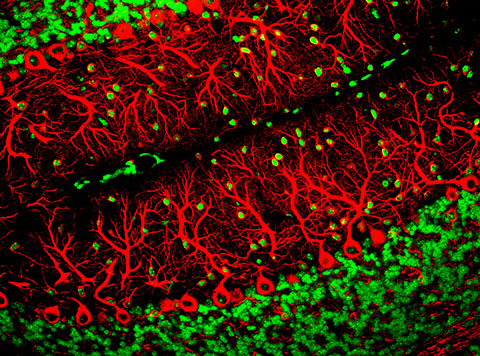Neurodegenerative disease linked to microtubules
First characterized in Quebec in 1978, autosomal recessive spastic ataxia of Charlevoix–Saguenay, or ARSACS, is a hereditary neurodegenerative disease. Symptoms such as difficulty walking often appear in early childhood and continue to progress, limiting the mobility and lifespan of those affected.
In particular, ARSACS affects the cerebellum, the region of the brain that controls motor skills. It is the second most common recessive form of ataxia, or loss of muscle coordination and movement, in the world.

No cure exists for ARSACS, but in 2000, a team at McGill University identified mutations in the protein sacsin as its cause. Developing therapeutics is a challenge, however, because researchers do not completely understand sacsin’s function. Although previously published work suggests sacsin may influence mitochondrial transport and function in neurons, its role in the cell is still unclear.
Vincent Francis, a postdoctoral fellow at McGill University, joined the laboratory of Peter McPherson because he was interested in neurodegeneration. In particular, Francis wanted to work on the understudied sacsin.
“I decided to pursue the project to understand the cellular function of sacsin, which could provide potential new therapeutic strategies for the treatment of the disease,” Francis wrote to ASBMB Today.
Previous work in the lab had focused on mitochondria, so Francis began looking at the transport of other organelles. He focused on the lysosome, the recycling center of the cell, where unwanted materials can be broken down and reused. Generally, lysosomes are clustered neatly around the nucleus. However, in cells without sacsin, lysosomes were scattered all around.
Lysosomes and other organelles are transported on microtubules. In neurons without sacsin, lysosomes move less. Based on their observations, Francis and the team hypothesized that sacsin could regulate the trafficking of cargo on microtubules.
“We assumed that sacsin could probably be functioning as an adaptor for organellar transport,” Francis wrote. “Instead, what surprised us was the ability of sacsin to bind to microtubules and to modulate microtubule dynamics.”
Microtubules are required for autolysomal reformation, a process in which new lysosomes are formed. Once again, without sacsin, cells showed a decrease in this process.
Because neurons are large, expansive cells, regulation of organelle trafficking is particularly important for their function.
This research, recently published in the Journal of Biological Chemistry, suggests sacsin is a key regulator of cellular traffic. In the future, the team hopes these results will inform research that can help identify treatments for patients with ARSACS.
Francis noted that several other neurological disorders — including Alzheimer’s disease — are associated with decreases in neuronal microtubule stability. This indicates that microtubules may be a promising therapeutic target for ARSACS and other neurodegenerative diseases.
Enjoy reading ASBMB Today?
Become a member to receive the print edition four times a year and the digital edition monthly.
Learn moreGet the latest from ASBMB Today
Enter your email address, and we’ll send you a weekly email with recent articles, interviews and more.
Latest in Science
Science highlights or most popular articles

Exploring the link between lipids and longevity
Meng Wang will present her work on metabolism and aging at the ASBMB Annual Meeting, March 7-10, just outside of Washington, D.C.

Defining a ‘crucial gatekeeper’ of lipid metabolism
George Carman receives the Herbert Tabor Research Award at the ASBMB Annual Meeting, March 7–10, just outside of Washington, D.C.

The science of staying strong
Muscles power every movement, but they also tell the story of aging itself. Scientists are uncovering how strength fades, why some species resist it and what lifestyle and molecular clues could help preserve muscle health for life.

Bacteriophage protein could make queso fresco safer
Researchers characterized the structure and function of PlyP100, a bacteriophage protein that shows promise as a food-safe antimicrobial for preventing Listeria monocytogenes growth in fresh cheeses.

Building the blueprint to block HIV
Wesley Sundquist will present his work on the HIV capsid and revolutionary drug, Lenacapavir, at the ASBMB Annual Meeting, March 7–10, in Maryland.

Gut microbes hijack cancer pathway in high-fat diets
Researchers at the Feinstein Institutes for Medical Research found that a high-fat diet increases ammonia-producing bacteria in the gut microbiome of mice, which in turn disrupts TGF-β signaling and promotes colorectal cancer.

